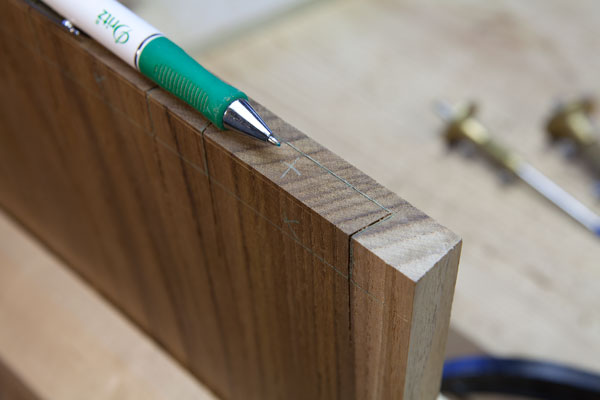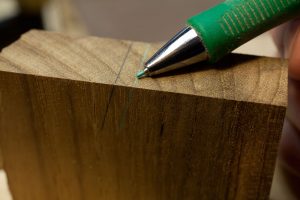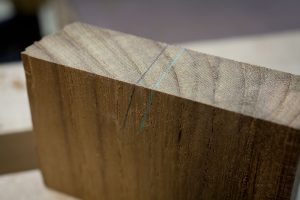We may receive a commission when you use our affiliate links. However, this does not impact our recommendations.
For me, one of the biggest challenges when working with dark-colored woods is marking them out for sawing and chiseling. Knife lines and pencil lines disappear into the tangle of growth rings and – if it’s a porous wood – pores.
I’ve been dovetailing teak this week for a campaign chest I’m building and have had a devil of a time marking out my joints.
Then I remembered a tailor’s marking pencil that a friend had brought to the shop during the summer. It’s made by Dritz, and you can find it at sewing and craft stores as a “Tailor’s Marking Set.”
If you haven’t found a satisfactory way to mark dark woods, this one is worth checking out.
It’s like a mechanical pencil. But instead of a traditional lead, the pencil dispenses a .9mm colored ceramic that has a waxy feel to it – like a tiny and stout crayon. The set comes with green and pink ceramic lead.
For my eyes, it makes a line that is easier to see than that of a traditional lead. I don’t think the photos that go with this blog entry really capture the difference between pencil lead and the ceramic lead. The pencil lead is only really visible when the light catches it at a certain angle, which also happens to be the angle that it appears for photography.
I think it’s also a matter of contrast. I can see a green or pink line against a dark-brown board more easily than I can see a black pencil line.
Of course, the Dritz isn’t perfect. The ceramic lead breaks fairly easily, so you have to be gentle when you mark out. Also, it’s easy to make a line of inconsistent width. So what I do is much like when working with a “pounce bag.” I knife in all my joints as per usual. Then I run the ceramic ink over the line. This reveals the line.
So far, I prefer the Dritz to a pounce bag because it’s a lot less messy – there’s no chalk or talc dust everywhere.
I know there are a lot of solutions out there to the problem of marking out dark woods. If you have found something you are happy with, stick with it. If you are still struggling, the Dritz pencil is something to consider. It’s inexpensive, easy to use and doesn’t make a mess.
— Christopher Schwarz
Related resources you might find useful:
• More techniques: I’ve written about marking out on dark woods before on the blog here (on pounce bags). And here on inks.
• More on design: If you would like to read more about my campaign furniture, you can read more blog entries here.
• Good book: “The Foundations of Better Woodworking” by Jeff Miller is a great introduction to building a set of hand and body skills for the workshop.
Here are some supplies and tools we find essential in our everyday work around the shop. We may receive a commission from sales referred by our links; however, we have carefully selected these products for their usefulness and quality.












In my vast cache of treasures I came across a welders soapstone marker makes great visible white marks on dark wood can be sharpened to a razors edge costs under two bucks at a welding supply house or online
I just use white Stabilo Colored Marking Pencils availible online from a number or places. They’re more like a number 2 in size and the “lead” is waxy. Soft, so don’t press hard, but the white sure is clear on walnut.
I get a 12 pack
I have also had good luck with Sewline ceramic lead. It is also .9 mm and comes in five colors – black, white, pink, green and yellow. I prefer the white for dark woods. It rubs off easily after making your cut. Load it up in your favorite .9mm drafting pencil and you’re ready to go.
Chris
I seem to remember that you use the 0.5mm propelling pencils. If that’s true, you can get green and red leads for them as well (you can even get scented ones if you are so inclined!)
Kind regards – John
The tailor’s pencil can be found here: http://www.amazon.com/Dritz-Tailors-Marking-Set/dp/B0052WSQHK
I have one with a white lead that I’ve been using for several years. I wouldn’t know what to do without it.
Just must depend on a persons eye I guees. In your second and third photos I can see the darker pencil line much clearer.
Hey Chris,
I’ve used a knife and school yard chalk for years on dark woods, sort of a compromise between the tailor’s pencil and the ponce bag. I’m not sure what the advantage of a ponce bag would be, the school yard chalk is easy to see, and less messy. I’ll have to give the tailor’s pencil a try.
Tom
I just bought the “Tailor’s Marking Set” on Amazon for less than $3 and shipping. Thanks for the great blog post!
Try a Pilot Precise V5 Rolling Ball, Extra Fine. Has a .5mm ball & comes in different colors of ink. I like red for most stuff. Also comes as V7 (.7mm ball). Office supply stores
Great tip! Regarding the inconsistent width line…in my drafting days I learned to spin my pencil slowly as I ran down the line, this would help to keep the lead from wearing flat and making a thick line. Also, I know that you can buy colored leads for mechanical pencils. I’ve seen blue, green, red, and yellow. I’ve never tried them on wood, but it may be worth a shot.
I prefer the knife cuts but gave up on pouncing bags and socks a long time ago. I put the talc in a re-purposed plastic mustard bottle, the squeeze kind with a long pointed nozzle, many different products use them. Turn down the nozzle to reduce the flow rate and you can lay a small line on your score, then blow the small amount of excess away. On really dark walnut I use a pencil by first filing the surface with a double bastard cut file, it turns the wood beige and pencil lines shows up on it well. Teak I don’t know about filing but the talc will work well.
I have had a lot of luck with blue masking tape. I cover the surfaces with the tape then do my layout and cut through it. You just have to be sure to get the tape on smoothly and it should work just fine.
Generals white charcoal pencil, they even come with a very good pencil sharpener in the 2 pack. It takes a good point, holds up well, and comes off the wood easily. Plus it is white and against dark woods your marks are very clear at any angle.
I have used a silver colored pencil on walnut. I like the way it reflects light from all directions compared to graphite which favors one angle. Unfortunately it is soft.
I use a green colored pencil for dark woods; works great. Like your tailor’s pen, the ‘lead’ is soft and needs to be sharpened often. They are very inexpensive, even by the dozen.
Jim Tolpin turned me on to china markers. Now I have china markers (aka grease pencil), and green colored pencils all over the place.
Unrelated to anything, I now also use clear page protectors and a grease pencil to experiment with curves, etc. on the face of the wood. Nothing answers the question ‘does it look right?’ better than a picture right on the wood.